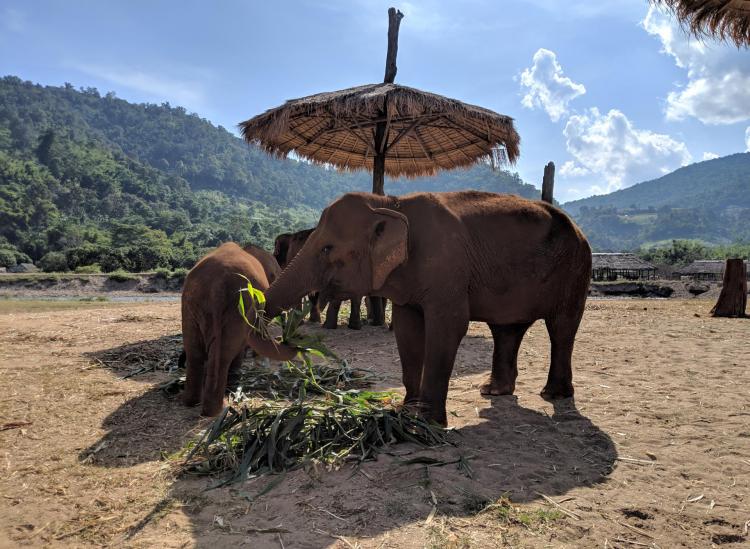What To Expect When You Visit An ‘Ethical’ Elephant Sanctuary

Libby Ryan
In November, an elephant hugged me and I achieved a lifelong dream of being cuddled by one of the giant animals. I visited Elephant Nature Park, one of the few spots in Thailand where the happiness of the elephants is the top priority, to see what it’s like to hang out with elephants. We’ve all seen beaming faces next to an elephant on Instagram, but what’s happening IRL and what should travelers know before choosing a sanctuary?
First things first, ask yourself: Is it really worth a tick on your bucket list if the elephants you’re meeting aren’t living happy lives? Probably not. You want to meet the happiest giants out there, animals who are able to live in an environment as close to the wild as possible. So here’s what we learned while chilling with some of them and what you need to know when looking for a way to do so yourself.
How do you know if elephants are well-treated?
Elephants have expressive faces that can tell you a lot about their living situation, but beyond their body language, you can look for signs that the elephants are herded around their homes using sharp tools. Anywhere that’s using scary bullhooks (or worse) to get an elephant to behave isn’t somewhere where you want to spend your money.
It’s also good to find a destination that is “chain-free,” meaning the elephants are never chained and get to roam free. You also want to look to see if the elephants have access to shade — it gets hot in Thailand — and water.
Can you swim with elephants?
Splashing around with elephants looks fantastic on Instagram, but it’s not great for the elephants themselves.
“In some places, this means a lot of people every hour with the elephants in the water,” Action for Elephants UK founder Maria Mossman told The Guardian last year. “It’s not natural for an elephant to be in the water all day with lots of people climbing all over them.”
Instead, choose a sanctuary that offers the chance to observe elephants happily bathing themselves in water and mud. Yeah, the photos might not be on quite the same level, but imagine if someone used your nose for a hose like some elephant tours do with those poor animals trunks.
What about riding elephants?
For years, elephant riding was one of the big tourists draws in Southeast Asia and Africa, but now we know a lot more about the tragic things that happen to those elephants used for riding. Yes, elephants are enormous, but they’re not built to be ridden by humans. Your body weight alone might not make much of a dent in an elephant’s body weight, but the contraptions used to hold humans on an elephant’s back aren’t comfortable for the gentle giants. And that’s not even addressing the horrific processes used to train an elephant to carry humans. They intentionally break the animals’ spirits.
“A baby is taken away from its mother and tortured until it’s broken and timid. Elephants that are used in tourism are often chained up by themselves,” Animal Experience International founder Nora Livingstone told Travel and Leisure last year.
So we’re going to go with a resounding “no” to the possibility of riding elephants. After all, it’s much more rewarding to have animals come to you out of their own free will rather than take a ride.
RELATED
Here’s Where To Find The Best Elephant Sanctuaries In Thailand
This Is The Best Wildlife Destination For You, Based On Your Favorite Animal











